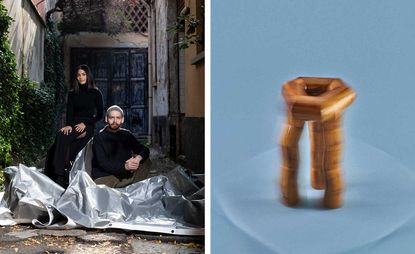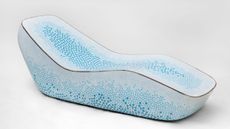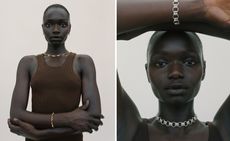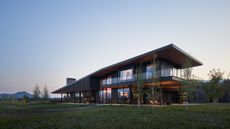Cara \ Davide, the Milanese design duo inventing a new design language
In our Future Icons series, we explore ten next-generation designers who have made us sit up and take notice: here, we speak to Cara \ Davide about their design process and their cross-cultural inspirations
- (opens in new tab)
- (opens in new tab)
- (opens in new tab)
- Sign up to our newsletter Newsletter

Founded in 2016 in Milan by Cara Judd, an interior design graduate from South Africa, and Davide Gramatica, an Italian product designer, Cara \ Davide creates diverse furniture pieces with resolutely sculptural forms.
Inspired by the pair’s cross-cultural background, as well as a fascination with materials, techniques and processes related to different territories, their work is simultaneously contemporary and ancestral. ‘Slow, instinctive, dialectic’ is how Judd and Gramatica describe themselves. From the synthesis of their two personalities and their creative process, Cara \ Davide comes into being.

Chair from the ‘Segmento’ Collection
‘Segmento’ is the studio’s latest project, fuelled by the idea of breaking down and reassembling pine logs, and the collection includes a bench, chair and stool – ordinary enough objects but in an abstracted form. ‘Thick logs, solid and linear, are cut into segments and reassembled into compact and curving lines to create furniture of a fractured and angular nature, never symmetrical but different from any perspective,’ they say.

‘Territorio’ chair
One of their first projects, Territorio – composed of a stool, a chair, and a cabinet, whose colour palette and shapes ‘pay tribute to the beauty of an African aesthetic’ – celebrates the harmony between the two designers while also highlighting the studio’s deep and respectful investigation of the materials. Territorio (meaning territory in Italian) was indeed a turning point for the duo, as they both affirm: ‘with this project, we feel that we managed to find a special meeting point of culture, context, material and production that represents us personally and as a duo and it has become the baseline of our work and practice.’

‘Wave’ Tray for Muuto
Since 2016, they have produced diverse furniture pieces with resolute and sculptural forms. From their Mobili Sintetici, basic and pure wooden elements, and their Calandra series, showcasing welding techniques and curvilinear shapes, to a collaboration with Danish design brand Muuto.
Through organic shapes, international influences, textured surfaces, and a dedicated material investigation, Cara \ Davide found its signature style with a very personal direction.
caradavide.com (opens in new tab)

Maria Cristina Didero is an independent design curator, consultant and author, who has contributed to many publications over the years; she is currently Milan editor of Wallpaper* . Didero has consulted for companies such as Vitra, Fritz Hansen, Lexus, Fendi, Louis Vuitton, Valextra among others. Based in Milan, she works internationally, curating exhibitions for institutions: some of her most recent projects include Nendo: The Space in Between and The Conversation Show at the Holon Design Museum, Israel; FUN HOUSE by Snarkitecture at National Building Museum, Washington D.C.; SuperDesign a project about Italian radical design, NY; Vegan Design, or the Art of Reduction by Erez Nevi and The Fish and The Crowd by Carlo Massoud, Milan. In April 2022 she curated a Mathieu Lehanneur exhibition at the Triennale in Milan called The Inventory of Life, while in July she debuted a project at the MK&G in Hamburg titled Ask Me if I Believe in the Future, alongside a series of ongoing collaborations. She was appointed 2022 Curatorial Director of Design Miami/. She is currently preparing two projects for Milan Design Week 2023.
-
 Last chance to see: Marc Newson’s all-blue designs in Athens
Last chance to see: Marc Newson’s all-blue designs in AthensGagosian gallery Athens presents new blue furniture and objects by Marc Newson
By Rosa Bertoli • Published
-
 Sapir Bachar’s love for silver makes for abstract jewellery forms
Sapir Bachar’s love for silver makes for abstract jewellery formsSapir Bachar’s fashion background informs her eponymous jewellery brand
By Pei-Ru Keh • Published
-
 Spectacular Wyoming ranch sits within a restored working landscape
Spectacular Wyoming ranch sits within a restored working landscapeThis Wyoming ranch by CLB Architects offers a new approach to the Western architectural tradition, combining daring and functional modern design with a welcoming character
By Jonathan Bell • Published


